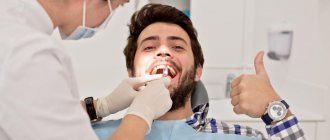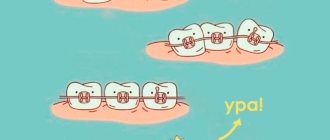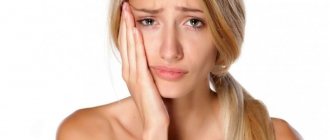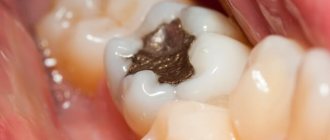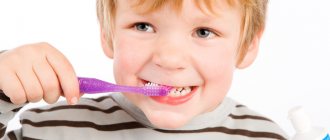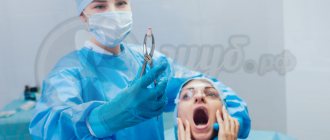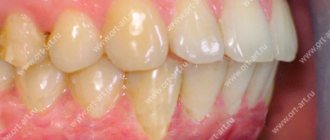Causes
One of the main causes of abnormal bite is genetic predisposition. The hereditary factor is activated against the background of concomitant causes - chronic diseases or bad habits.
Various internal and external factors contribute to protruding front teeth.
You can get rid of the problem in several ways - from performing myogymnastics to installing orthodontic devices.
The choice of treatment depends on the patient’s age and the severity of the defect.
All newborns have a distal position of the lower jaw. The norm is considered to be a deviation from the level of the upper dentition by 1-10 mm. In the absence of problems in the child’s development and breastfeeding, the bite gradually returns to an orthognathic state. In addition to hereditary factors, there are a number of factors that can cause protruding teeth.
One condition that may require surgery may be gothic palate.
This type of oral cavity structure is characterized by an excessively high position of the upper wall of the oral cavity. The cause can be both congenital and acquired pathologies in childhood.
Dentist
Novikova Olga Alexandrovna
8 years of experience
General somatic diseases of the patient
According to statistics, abnormal bite is observed in 60% of people who suffered from rickets in childhood. Also, inflammatory processes on the mucous membranes of the mouth, short frenulum, and injuries lead to a pathological condition. The anomaly can even develop as a result of improper positioning of the child during rest.
Chronic nasopharyngeal disease
About 35% of people who have problems with nasal breathing are faced with the problem of an abnormal bite. Such pathologies include:
- inflammation of adenoid tissue;
- deviated nasal septum;
- constant runny nose.
The upper teeth protrude in children who often suffer from ARVI. With a runny nose, the child is forced to constantly breathe through the mouth, which leads to the development of a high palate. In this condition, the upper jaw becomes deformed and protrudes forward.
Bad habits (especially in children)
For example, biting nails, sucking fingers or foreign objects. This causes changes in facial proportions, including distal occlusion.
Children often have several habits at once, leading to the formation of occlusion or the development of one of them into another, for example, incorrect posture. Curvature of the spinal column entails many problems, including orthodontic ones.
Early change of baby teeth
If baby teeth are severely damaged by caries, the dentist may decide to remove several elements of the row. The nearby bone structures begin to shift to free areas. As a result, there is no longer any space left for the molars, and they begin to grow upward.
Consequences of malocclusion
If a malocclusion is suspected, children should be examined by a pediatric dentist, otolaryngologist, orthodontist, or speech therapist. In this case, the main role in determining malocclusion belongs, of course, to the orthodontist. To carry out calculations and accurately diagnose, a panoramic image is required, as well as an X-ray examination of the skull. In addition, a photograph of the child's face may be required.
Finally, to determine the exact position of the teeth in the oral cavity, an alginate impression is made, on the basis of which a plaster model of the dentition can be made. With its help you can see the exact location of the teeth. To clarify the diagnosis, computed tomography and myography may be required.
Pathological bite is not just an aesthetic problem. Any deviation from the normal position of the teeth leads to improper load on the teeth. In the process of chewing food, teeth begin to wear down excessively, which can lead to the development of bruxism, when a child grinds his teeth heavily during sleep. Because of this, the tooth begins to be affected by caries.
In addition, abnormal tooth mobility develops due to improper positioning of the teeth. If this condition is not treated, teeth will begin to fall out over time. Due to the pathological development of the temporomandibular joint, frequent headaches and clicking sounds appear when opening the mouth. Since the incorrect position of the teeth strains the joint and muscles, constant muscle pain occurs.
Aesthetic problems manifest themselves in the fact that the child’s facial profile changes. He has an ugly smile because his teeth are crooked. Sometimes the degree of tooth curvature is so pronounced that the child is completely ashamed to smile.
All these consequences together significantly worsen the child’s quality of life. So this pathology must be corrected in time.
Classification
With pathology, the upper teeth protrude forward, completely or partially covering the lower row. In this position, the jaws can no longer close together normally. In rare cases, an abnormal location is observed not in the front, but in the lateral teeth of the upper jaw.
There are 2 types of pathology:
- Neutral bite. This anomaly cannot always be determined by external examination of the oral cavity. Even in an adult whose bone tissue is fully formed, the pathology may not manifest characteristic signs. In the case of a neutral occlusion, the chin does not change its natural structure, and serious facial disproportions are not noticeable. The main signs of the pathological condition are the overlap of the lower jaw with the teeth of the upper row, the presence of a noticeable supramental fold.
- Distal bite. In such a situation, the symptoms of pathology are clearly expressed. In adults, there is disproportion of the face, with the chin being unnaturally small and slightly moved back.
The diagnosis of malocclusion is made definitively after examination by a dentist.
Correction of misaligned teeth
What to do if you see, for example, how the teeth on the lower jaw have shifted?
It seems to many that it is no longer possible to correct the situation in adulthood - the teeth will still return to the wrong position, and besides, correcting the bite is long, difficult and unaesthetic. Fortunately, orthodontists today are successfully correcting misalignments in adult patients. To do this, they use 2 orthodontic systems, which, using the pressure of a calculated force, carefully move the teeth to the correct position.
- Braces
A classic non-removable system that consists of a metal arch, braces - elements that are fixed to each tooth, and locks or ligatures that secure the arch in the braces. Today, these systems have become much more compact and comfortable, and we are no longer talking about long years of correction, since the average treatment period is only 1.5–2 years. Doctors have metal, ceramic, sapphire and combined systems at their disposal. There are also lingual braces - they are fixed on the lingual side of the teeth and are not visible when you smile. - Aligners
A removable system of aligners developed about 3 years ago that are worn on the teeth. For each patient, based on photographs and impressions of the jaws, an individual set of aligners is created, which the patient himself changes according to a schedule drawn up by the orthodontist. Unlike braces, aligners can be removed for 2 hours a day to eat and brush your teeth.
However, in any case, after removing the orthodontic system and completing the bite correction, a period of retention follows - when the patient wears retainers that prevent the teeth from returning to their previous position.
Symptoms
Symptoms of the problem are classified into two categories - facial and oral. The main features of the first group are as follows:
- strongly pushed forward;
- crooked chin;
- shortened lower third of the skull;
- protruding upper lip;
- sharply defined supramental fold;
- parted mouth.
Among the functional signs are noted:
- the appearance sagittal fissure;
- abnormal position of the lateral teeth;
- difficulty chewing food;
- pain in the temporal region;
- impaired speech functions.
Other symptoms of pathology occur depending on the cause of the abnormal bite. One of the listed symptoms is a reason to contact an orthodontist. In a child, pathology is easier to eliminate than in adults, since in childhood the location of the teeth is not yet completely fixed.
Why can our articles be trusted?
We make health information clear, accessible and relevant.
- All articles are checked by practicing doctors.
- We take scientific literature and the latest research as a basis.
- We publish detailed articles that answer all questions.
Without medical attention, a distal bite can cause complications such as teeth grinding or bruxism. The latter type of disease often manifests itself after treatment of the problem, if the therapy was carried out too late.
How can you solve the problem?
A layman will immediately name two obvious solutions:
- remove protruded tooth;
- file down its coronal part.
Removing a tooth without pain can only be justified by its severe destruction, and even accompanied by the patient’s complete reluctance to seriously engage in dental treatment.
Filing the crown does not seem rational either. After all, for this you will have to remove the nerve of the tooth, since it will have to be “shortened” by more than half, and then covered with an artificial crown. It is difficult to call the formed “formation” a full-fledged tooth. “Grinding” is not required only when the molar is slightly advanced, when you can limit yourself to grinding its cusps to the existing bite height.
The best option is orthodontic treatment, since it is the orthodontist who deals with problems of tooth displacement. Modern technologies make it possible to return a “failed” upper molar to its place.
Diagnostics
Diagnosis of pathology includes not only identifying an abnormal bite, but also determining the cause of its occurrence. To accurately assess the condition of the jaw system, a set of measures is carried out:
- Teperentgenography. Thanks to the procedure, the doctor identifies existing defects in the jaw bones and also assesses the condition of the alveolar processes.
- Tomography. It is prescribed to determine the localization of the head of the mandibular joint.
- Casts. Models are used to study the structural features of bone tissue elements.
- Electromyography. Prescribed when analyzing the chewing functions of the jaw.
- Study of the dentition using the Schwartz method. The technique allows you to identify a type of abnormal bite.
- test . Another way to determine the type of pathology.
Mini-implants - as a basis for orthodontic treatment
The procedure for installing mini-implants is carried out under local anesthesia and does not require any incisions or sutures. A puncture is simply made in the tissue through which the surgeon implants a titanium implant. But simple and low-traumatic manipulations should be performed by a highly qualified specialist who can take into account the peculiarities of the location of the dental roots so as not to injure the tooth.
- In this example, small orthodontic dental implants will be installed next to the lowered upper “seven” - one each on the vestibular (external) and lingual (internal) sides.
- The orthodontist will glue special hooks to the molar on both sides, which will be connected to the heads of the implants using elastics. This way, the doctor will create a constant force, supported by the implants, pulling the sagging tooth back into the jaw bone.
- As with treatment with braces, stretchable elastic bands will need to be replaced periodically, for which you will have to visit the clinic. At the same time, the orthodontist will monitor the process, correcting the movement of the problem tooth.
As a result, a place for prosthetics will be obtained without removing, depulping or grinding the molar.
How to correct an overbite
To correct malocclusion at an early age, more gentle methods are used. An effective method of combating abnormal bite is gymnastics for the facial muscles. Such exercises in medicine are called myogymnastics. The results of the procedure can only be achieved with regular exercise.
Bite trainers
In order to correct bites in children and even simple dental defects in adults, it is not at all necessary to install complex, inconvenient and expensive devices.
The following types of gymnastic techniques are common:
- Bringing the lower jaw forward. Remain in this position for several minutes, and then relax the facial muscles. Gymnastics are performed until a feeling of fatigue appears in the jaw muscles.
- Raising the tongue. During the exercise, the tongue extends and rises to the area of the upper palate.
Correction of abnormal bite in children
Maximum results can be achieved by combining myogymnastics and orthodontic devices. To correct the bite on baby teeth, devices with screws are used that regulate the width of the structure and the development of bone structures.
In some cases, trainers or LD activators are prescribed to correct the defect. The main purpose of using structures is to give the lower jaw a natural position and relax the facial muscles.
Orthodontic appliances are effective for both primary and molar teeth. Removable dentures can be used before installing braces, while the use of trainers reduces the time of wearing the regulatory system. It is important to remember that you can achieve results from wearing removable correctors only with their regular use.
In children from 8 years of age, Twin Block systems can be used to correct the bite. The device consists of two plates that act on bone tissue mechanically. In this case, the lower jaw moves forward. Before installing the system, I take an impression of the teeth and determine the type of anomaly.
In some cases, patients are offered the installation of partial braces on already renewed teeth. The design allows you to align abnormally located elements and give them the correct angle.
In advanced cases of problems or when the above methods do not produce results, the Herbst device is used. It consists of two spring elements, one of which is attached to the upper jaw (sixes), and the other to the lower row of teeth (premolars). The mechanism gradually aligns the position of the jaw system, pushing the lower row of teeth forward and the upper row back.
Methods for eliminating the defect
Direct veneers or crowns can be used to correct protruding teeth. But this method is more of an aesthetic nature. It does not solve the problem at the root, but only masks it. Veneers are suitable if one or maximum two teeth are protruding.
To correct the bite, it is recommended to use braces. The disadvantage of this treatment is the long period. But the advantages are invaluable, because as a result it is possible to correct the location of each individual tooth.
In some cases, several teeth may have to be removed. This is done when there is a lot of crowding and there is no space for straightening the teeth.
If the central teeth protrude after wearing braces, a different treatment system is used.
During the so-called retention period it is recommended to use:
- removable retainers;
- fixed retainers.
Which type to choose depends on the complexity of the curvature. If it is minor, removable mouthguards are used. They are plastic overlays that perfectly fit the shape of your teeth. Mouthguards are made individually, based on an impression. If it is necessary to strengthen the structure, wire is installed in the retainers. The orthodontist develops a plan for wearing mouth guards.
Fixed retainers are metal arches. They are attached to problem areas and cannot be removed. Fixation occurs on the inside of the teeth, so the patient does not feel discomfort when wearing them. The duration of use of the arches, as well as their shape, is selected individually.
Unfortunately, the problem of protruding teeth cannot always be solved with veneers or braces. If long-term correction does not give the desired result, the doctor may recommend using the Herbst apparatus. The non-removable design corrects even very complex defects in just 1 year. Changes are visible immediately after its fixation. The Herbst appliance gradually moves the upper jaw backward and the lower jaw forward.
Reverse overlap of incisors
Reverse incisor overlap is when the lower teeth protrude forward). Reverse overlap blocks the normal growth of the upper jaw in length. The most optimal time to correct such a bite is from the age of 5-6 years. At this age, the incisors of the upper and lower jaws erupt and this is the most favorable time to begin orthodontic correction. If you notice a reverse overlap in a child at a later age, it is also important to contact an orthodontist in order to rid the upper jaw of the blockage as quickly as possible and give it the opportunity to continue to grow actively.
Asymmetry in the face, smile, bite
If you notice any signs of asymmetry in a child, this is a reason to immediately consult a doctor. At any age of the child - as soon as noticed. Of course, all people are naturally asymmetrical. But natural asymmetry is not visible to the eye and does not attract attention. What you need to pay attention to in terms of asymmetry: • displacement of the chin to the side • the smile is not symmetrical • the central lines of the upper and lower jaws do not coincide (with each other and with the central line of the face). The orthodontist will be able to conduct an examination and prescribe the necessary treatment or examination to identify the causes of asymmetry.


